

Matt & Jessica's Sailing Page
Experiencing the world while it's still large
What is it Going to COST to BUILD a Kit CATAMARAN? – A Comprehensive Guide (MJ Sailing)
The big question on everyone’s mind is … what is it going to COST us to build this new catamaran?
Matt has spent the past few weeks talking to the designers at Schionning and Oram, as well as professional and ameture builders to gather as much information as possible on the costs that go into building a kit catamaran. Things can obviously vary from builder to builder, but taking a simple and basic approach, we’ve narrowed down the numbers on what we estimate it will cost to build an Oram 45R.
To take a look at the full design specs, take a look here: https://www.boboramdesign.com/45r
For a quick look at the numbers, check our website: https://www.mjsailing.com/cos/oram-45r…
For a download of the spreadsheet, click here: https://www.mjsailing.com/wp-content/u…
After discussing previous builds with the many others who’ve come before us, we found out there is one small thing that can skyrocket a budget – and that is making customizations after you’ve started the build. But, if you start with good plans and commit yourself to them, it is very feesable to stick to your original budget.
Sending the above spreadsheet to both designers and builders, and asking if they were realistic figures, they all came back stating that we’ve covered all aspects and should be able to complete the project within the budget we have listed. And that, is music to our ears!!
Since this is a very long video because we have tried to keep it as detailed as possible, here is an outline of subjects covered if you’d like to bounce through to the areas that interest you:
0:00:00 – Intro by Jessica 0:03:50 – Intro by Matt 0:15:32 – Intro To Budget 0:16:30 – Costs relating to Kit 0:21:45 – Total cost of Kit shipped to the US 0:24:23 – Costs relating to Building Supplies 0:32:10 – Total costs of Building Supplies 0:32:53 – Total cost of First Year of Build (getting to paint stage) 0:35:41 – Costs relating to Paint 0:39:05 – Costs relating to Sailing (rig, sails and deck hardware) 0:45:17 – Total costs of Sailing 45:38 – Costs relating to Engines 0:50:42 – Costs relating to Steering 0:52:32 – Costs relating to Electrical System 1:00:50 – Total costs of Electrical System 1:01:07 – Costs relating to Achor (anchor, chain/rope, windlass, docking gear) 1:04:05 – Costs relating to Lights 1:07:17 – Costs relating to Galley 1:12:07 – Costs relating to Exterior 1:16:53 – Costs relating to Interior 1:17:45 – Costs relating to Heads 1:19:12 – Costs relating to Electronics 1:22:20 – TOTAL COST OF BUILD 1:26:40 – Closing by Jessica
Much love from England! Jessica, Matt & Georgie
9 Responses
Hey again M&J
Just watched you cost vid, pretty much covered it all. Awesome. I had another thought for you on the kit, ask Bob (Oram) or Jeff (Schionning) if shipping is mandatory with their kits. What I mean is, both use west system epoxy mostly although our kit also included atl kinetics resin for under waterline wetout, nevertheless you may be able to source that (and the various powder additives) locally rather than pay international shipping on it, same goes with double bias and uni glass, which leaves the composite panels. I have heard that designers may sell you the rights (single use) to the CNC files but it very much depends on if they know and trust the composite panel makers. If they do there may be a company similar to ATL in the US to make you the panels. Just a thought based solely on the absurdity of West being made in the US, shipped to Australia only to be shipped back.
Great to hear from you! *anyone reading this- Paul built a beautiful Schionning cat and did the best documentation I’ve seen of the process at Yikes.com.au
Funny, the first suggestion I received from Oram was to get my epoxy in the US. Not only is it cheaper, but apparently Epoxy is a hazardous material and just the mess of importing it is best to be avoided. But we’ll probably source the fiberglass straight from ATL. Â In the US it’s more difficult than it should be to get the designer’s suggested cloth weave and weight. Our common weights are just different enough to cause some problems that I don’t want to have to reengineer for.
I did a cursory budget for building the panels myself, but unless my supplier’s bulk pricing was way too high, the ATL price vs infusing my own panels were surprisingly close – and it was even closer getting them from Schionning’s South African manufacturer. Buying 200 sheets of Divinycell still didn’t get me into the price point to make it worthwhile 🙂 But adding the savings along with not needing shipping and import does get to the point that we’d essentially be paying ourselves a fair wage to infuse them, but I keep thinking that all it takes is one bad hull length infusion and we’d be at a large loss. It would give us continuous panels without need joints, but the South African panels are 40′ long and only need one seam now… so hardly a big benefit there either. That debate still rages on 🙂
Get out there and use that awesome boat! I can’t believe it’s been sitting on the mooring for so long without you guys at least using it as a power boat.
Hey Matt, As I suspected there’s not much you don’t already know or scoped out. I hear you regarding infusion. I did a bit of research into the kss Kelsall process but in the end decided I perhaps don’t have quite enough skill or attention to detail to be confident in my ability to infuse a 40ft panel, the last thing you want is delamination. But the “out of a mold†with paint already on sure is attractive, if I was ever to build again, anything that reduces fairing is worth it’s weight in beer in my opinion. And yes, all going well we intend using Yikes later this year, if only around our home port but I have to get the ammenities and comfort up to spec to get Jo on board. Loved the Thai charter adventure vids. Cheers Paul
Great video. Thanks for compiling all this together. It’s compelling enough that I’m seriously considering actually going for it.
Couple of questions: 1. I’m trying to scout the building locations. I live in an apt so no access to a big backyard. I know you mentioned leasing a parking lot potentially .. do you have any pointers. Logistically that seems like a huge problem that I’m struggling to overcome given that leasing an industrial warehouse (if I can find one with the doors large enough) would be at least 20K per yer for the ~2000 sq feet I’d need. 2. Have you considered Spirited Designs (as in Sail Surf Roam). What is it that ultimately made you go the Oram route? Designs seem very similar between Schionning and Oram and even the layout seems similar. 3. Oram build hours estimate and the overall cost seems much lower than Schionning. Did you figure out why that is or am I misreading something.
Thanks in advance! Good luck with your new adventure!
Build location is something we’re still struggling with too. I’ve been limited to online searches and emailing agents (Craigslist is a good source) since we are still in the UK and unable to travel back to the US to personally scout out locations. But since we can build anywhere we want, we can pick the best climate for our build (epoxies have some environmental requirements) Where are you located?
It’s almost impossible to find a warehouse with large enough doors to get a cat out in one piece unless it’s an airplane hanger. The typical way most ‘home” builders do it is to remove the wall of the warehouse to pull the boat out… it’s not that hard or expensive to do on a steel building. You just have to find a landlord that is okay with you pulling off the siding/wall and taking a frame or two down for a few days.
The Spirited Designs is a great boat, but for us, it has a few minor traits that we are looking to avoid. Plus, the 38′ is smaller and the 48’ is bigger than we want… no happy medium is offered.
The ‘Cost’ video was just our breakdown for the Oram 45R… like the build video showed the Schionning. We haven’t decided on a design yet- the Oram, Schionning and Grainger are all still 100% in the running.
The Oram is a simpler boat to build. It has a single seam at the sheerline- Schionning is multiple panels that need to be taped and faired- and it doesn’t have the extra seam on deck (another set of panels less on the Oram), and even the cabin top has one less seam (and another panel set less). For better or worse, the stock interior plan is more basic on the Oram too. One simple thing that save a lot of time is the lack of secondary floor (sole) in the hulls. Down below you stand on the hull itself without an additional raised floor like on the other boats.
I haven’t seen Oram list a lower amount of time for the build than Schionning (Grainger does show higher hours). Bob’s site say 5500-7500 hours for the 45R, while Schionning’s site says 5,000 for the Arrow 1360 (design comparison PDF). Schionning shows cost as $260,000 AUD for the 1360 and Bob say’s from $205,500 AUD to $265,500+
And a final FYI- Grainger is doing some redesigns of the Raku- along with new pricing- and will have that information out in the next few days. From talking to Tony, it sounds like they are making a big push this year. Shoot him an email (graingerdesigns.net) and he’ll keep you in the loop with the new detail.
Matt Johnson MJSailing.com
Thanks for that response. I’m down in Miami. I like the year-round warmth for epoxy curing but not sure about the rain/humidity/hurricanes. I’m debating whether I should entrust someone like Ojigawan to build it in VA and just make the trips there as often as possible but that takes the fun/experience of building out of the equation, limits the learning, and last/not least raises the cost 🙂
I did get a quote for the Schionning Arrow 1360 out of Pantawee in Thailand — PM me if you’d like to know what that looks like. In my calculation it comes down to the hourly rate of about $29 which seems very high given that the generous wages in Thailand are about $5 per day.
Good to know about Grainger — will keep my eye out for those new designs.
Did you ask Julian at Current Marine in South Africa for a quote on the Schionning? They maybe a bit more competitive than the Thailand builder since they have so much experience with Schionning (they build the foam kits that Ojigawan uses). I think they also offer pretty good pricing on mast, hardware and all the other needed supplies in SA. Take a look at Current Marine’s CM45 too- it’s an awesome Schionning design.
Good tip. Will reach out to Julian.
By the way — made some progress with locations with some help from my realtor friend. You can find ~ 3k foot parking lots in the Miami area for about 1-1.5k per month. Not cheap but certainly an option. Typically they’re in the industrial areas which have some local laborers that can help with fairing, etc.
Another interesting data point is that some of the builders are estimating about 6500-7000 hours for the arrow 1360 build and trust that 5k hours gets you a very basic/rough boat.
BTW — did you see those new Graingers? pretty sweet! Apparently they have a promotion if you’re willing to purchase plans in the month of June — not sure the details.
The discount is 10% off for the month of June. If you talk to Grainger, tell him we sent you… we get a referral for each customer that acts as a discount for our kit 😉
We’ve found lots for around $500, but those are nowhere near populated areas like Miami. Besides the rain, humidity, heat and cold, one of my big fears with building in a lot is security. We can lock up to tools and supplies in the shipping container, but I’m really looking for a good fenced in area, but this has been a bit harder to find in our price range.
I think 7000 hours is a pretty accurate timeline for a novice builder. I’ve spoken to a guy that built a beautiful Arrow 1280s in 4,000 hours, but that seems to be exceptional and not at all average.
Add a Comment
Your email address will not be published. Required fields are marked *
This site uses Akismet to reduce spam. Learn how your comment data is processed .
- BUILDING RAKU FROM A KIT
- Duflex Kit Construction in 9 Steps
BUILD YOUR RAKU CAT WITH A DuFLEX KIT BY FOLLOWING THESE NINE BASIC STEPS

Step 1. Kit Design
Work with us to finalise the details of the design you have chosen including any design options or additional modules to be included in the kit.
We will determine the laminates, the number of panels required for each laminate, create the cutting files and prepare a quote for the kit if it is not already priced.
Once the design details and pricing are confirmed you are ready to place your order.

Step 2. Unpacking
2. The kit arrives at your workshop door, usually by container, as a stack of 1.2m x 2.4m routed composite panels ready to be joined. The shipment will normally include additional reinforcements, resins, and ancilary products as specified.
Unpack the shipment and stack the panels out of the way of the space where the panels will be joined.
If you have purchased a joined kit many of the panels will already be joined up to the length that can be shipped in a container (12m).

Step 3 Joining the Panels
Set up the work space where the panels are to be joined.
The panels have a scarf join called a Z join that facilitate the join without needing tapes.
The joining can be done with a heated Z press that cures the epoxy join quickly. Alternatively they can be joined with clamping pressure.
If the panel are are being joined with the Z press you will need an elevated work bench the full length of the longest panels you are using. (image below).
If you are joining them with a clamping technique the space can be on the factory floor.
A nesting booklet is provided with the kit to show how the panels are joined (right)

Joining the panels with clamping pressure

Panels are being joined into a single long panel by painting the surfaces of the scarf join with epoxy screwing through plywood battens that have a release film applied to one side.
Joining the panels with the Z Press

Step 4 Stacking Joined Panels
Once the joins are cured the panels are stacked to one side until they are needed for the job. The inividual parts should not be cut free of the panels until they are required.
Bulkhead and floor panels will be needed before the hull sides and cabin top so they should be left to the front of the stack wherever possible.

Step 5. Separating the Parts
When assembly is ready to begin the individual parts are separated from the panels by cutting the joining tabs. It is likely you will be building onto moulded hull bottoms that have been built from strip planking or another method of building moulded components. The process for building moulded components is described in another article.

Step 6. ASSEMBLY
As the joined panels are assembled onto the job you will need to apply glass tapes to the joins as specified in your plans.
Panels can be surfaced and coated inside and out with high build while they are on the workshop floor to minimise fairing time once they are assembled to the boat. The paint on the panels shown here has been kept back from the edges to provide a good bond for the tapes.

Smaller items such as steps, seats and dagger cases are nested into the kit and for the more complex parts diagrams are provided to assist with the assembly process.

Step 7. Interior
Interior kits can be ordered with the primary kit, or they can be ordered later when final decisions have been made about the interior arrangement.
A compromise solution is to order the interior as a set of plain planels that can be cut to shape on site after finalising the layout.

Step 8 Fairing, Painting, Hardware Installation
8. The DuFLEX construction process goes a long way to minising the amount of fairing that has to be done, but inevitably any boat that has not come out of a female mould will require some level of fairing and surface preparation prior to painting.
The fillers and resin systems required for the fairing work are normally supplied as part of the kit.
Hardware installation is the same as for any other form of construction using high density core inserts or consolidated laminate in way of fittings.

Step 9. Sailing
Go Sailing. This Barefoot 40 Catamaran was built entirely with a Duflex kit in Foam/Glass and Epoxy resin systems from ATL Composites

DuFLEX Kits are manufactured and supplied world wide by ATL Composites
atlcomposites.com.au
And in Europe by VDL Composites
www.vonderlinden.de/her/28/vdL-Composites-GmbH
For more information on DuFLEX and associated Products
atlcomposites.com.au/category/27/DuFLEX

Join the Newsletter

- Scroll to top
Construction plans only
The plans can be purchased separately and the materials can be sourced by the client at their own pace. A list of the required and recommended materials is provided.
Cad-drawn colour construction plans are supplied in an A3 sized booklet of high detail specifically suited to amateur building.
Study Plans
Study Plans are available for this design, please send a request via our Contact page.
How to Order your Spirited 480?
Purchase Order Please complete the online contact form. Online Form
Order Confirmation On receipt of your order form we will provide you with an order confirmation with the costs and deposit requirements.
Payment Generally a deposit is made at order and a final payment is made prior to dispatch. Payment for the larger design range is generally made via direct deposit and these bank details are provided on your order confirmation. Payments are made in Australian dollars.
Delivery Estimated delivery times is provided on the Order confirmation. We will contact you with a delivery date and delivery options once the kit has been ordered.
Contruction Plans Printed to order with customised cover sheets and any other design requirements to meets the clients requests.
Kits Pre-cut to order as standard or to meet any specific customised requirements.
Components Built to order as standard or to meet any specific customised requirements.
- Testimonials
P: (+61) 02 4981 8288
Disclaimer Copyright © 2013 Spirited Designs. All Rights Reserved.
March / April Issue No. 297 Preview Now
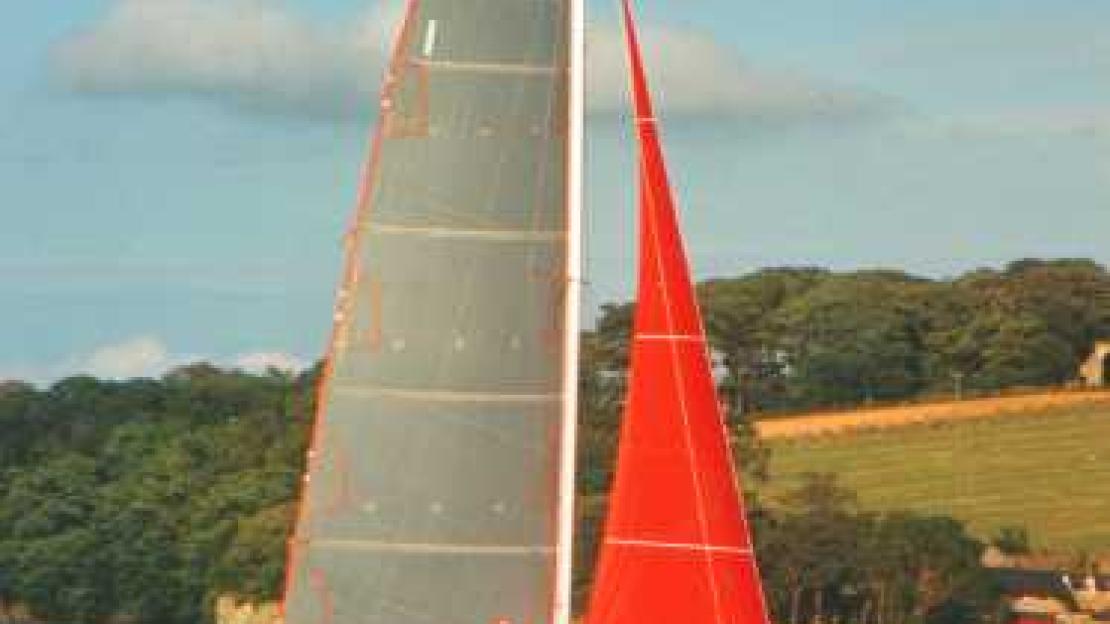
Wizard sailing catamaran
The WIZARD is a 22ft sailing catamaran design that offers 5–6 berths in 3 cabins, standing headroom, easy trailing, stability AND performance. For the first time in a trailable catamaran there is a genuine double bunk.It is legally trailable world-wide behind a family car. One person can assemble and rig it in under an hour ready for launching with no heavy lifting (e.g. the mast is raised using the trailer winch).The Wizard is roomy. In its 22′ length there are 5 berths in 3 cabins for privacy (3 singles in the hulls and one double on the bridge deck), a separate toilet compartment. Galley and a dinette seating 5. There is standing headroom in the galley using a “pop bottom” in the bridge deck.It is fast, the computer predicts speeds of 10 knots under power (with a 15hp outboard) and 16-18 knots under sail (with the racing rig). These prediction have been well proven many times in practice. Yet it remains maneuverable and easy to sail single-handed. It has shallow draft and is beachable.Also check out the Sango 25ft, the big sister to Wizard ,on my website www.sailingcatamarans.com
Design Specifications
Richard Woods of Woods Designs
Foss Quay, Millbrook, Torpoint, Cornwall, PL10 1EN, UK
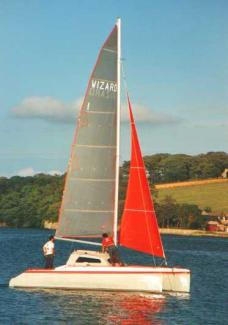
ACCESS TO EXPERIENCE
Subscribe today.
Publishing dynamic editorial content on boat design construction, and repair for more than 40 years.
1 YEAR SUBSCRIPTION (6 ISSUES)
Print $39.95, digital $28.00, print+digital $42.95, from plans & kits.
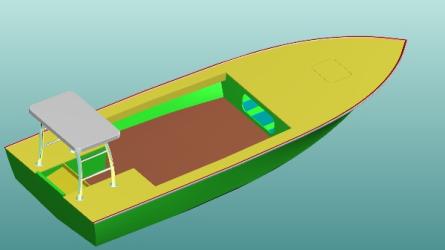
Paper Jet 14
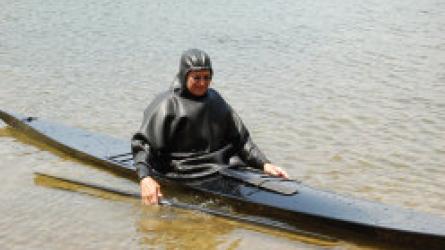
Ammassalik 176
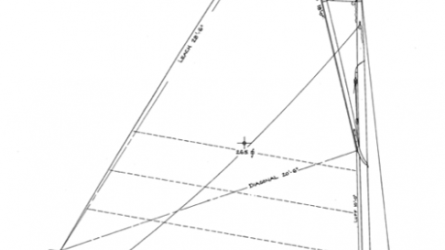
18' Catboat
From the community.
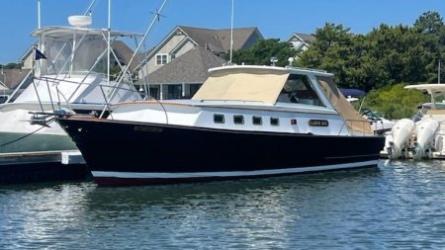
1968 Chris Craft Custom
1968 Chris Craft has been updated and customized for the classic boat lover.
50 years of WB, Sails, more
All original issues of WB, $375; Sails for sloop rig, new condition, luff 29’5” 2 jibs, bagged, $
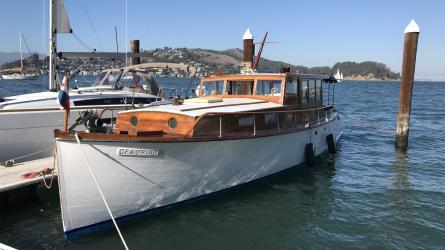
1941 36' Stephens motor yacht
She's FREE to anyone who can take on the project.
Register of Wooden Boats
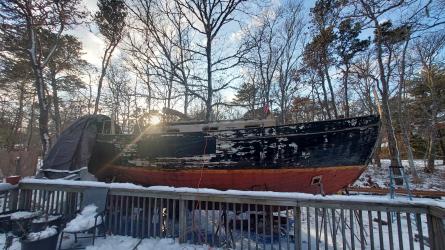
I aquired Maverick in November of 2023 for $1.

James Wharram Designs
Search Our Site
- Self Build Boats
- Professionally Built Boats
- Choosing a Boat
- How We Design
- Photo Gallery
- Video Gallery
- Articles & Blogs
- Wharram World
Mana 24 - Self-Assembly 'Cat-Kit'
Wharram's first kit boat.
Introducing the CNC-cut self-build 'Cat Kit', a trailable family camping boat. All plywood parts are pre-cut - just take it out of the box and assemble it yourself! Keep it at home, trail it and sail it anywhere. MANA is the Polynesian word for 'spirit' given to an object by its maker or the person that uses it.
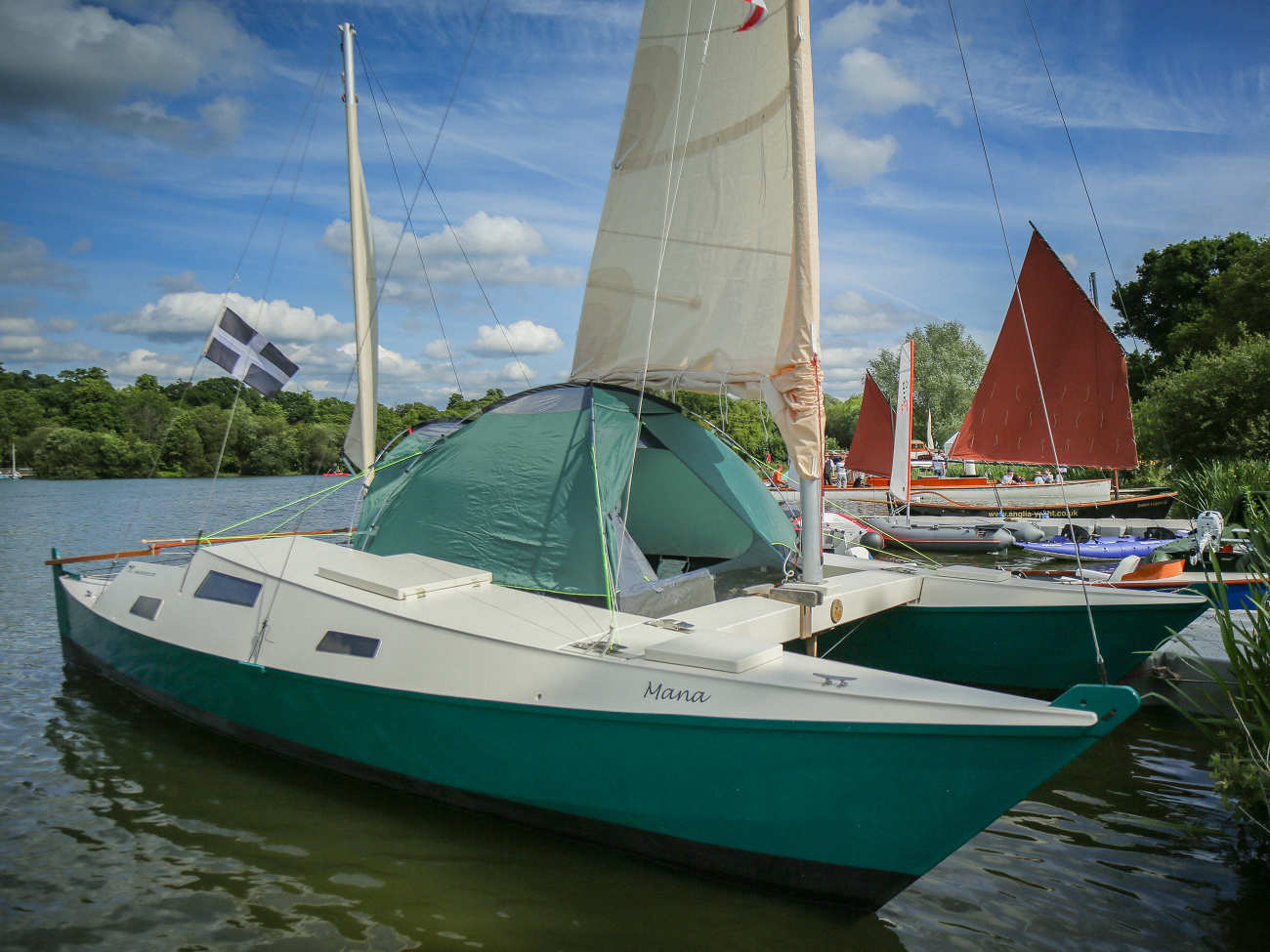
An Economical Way To Enjoy Sailing
Due to the present period of financial austerity and increasingly high marina costs, a large number of would-be sailors are having a hard time financing the dream of sailing their own boat.
However, there is an economical way to enjoy sailing, by building your own small lightweight boat, keeping it at home and trailing it to the waters you want to sail in , chasing the good weather. This gives the opportunity to explore many more sailing areas than if based on a permanent mooring and at a much lower cost.
In designing the MANA, we explored this idea and looked sideways into the world of camping and have combined the innovative CNC cut "flat pack" boat-building concept with the philosophy of outdoor living to create the unique MANA camper-sailer, specifically designed for trailer sailing.
All these ideas have come together, resulting in the new MANA 24 design, a catamaran specifically designed for trailer sailing. The MANA kit is sold with all the plywood cut out by CNC cutter , so building the boat at home will be a bit like assembling a flat-pack . All the parts slot together perfectly so a hull can take shape in a day.

Building from such a kit takes away the worry of measuring and cutting all the boat parts, which can be quite daunting to many first time builders and saves a lot of time in the early stages of building. As she is built from a pre-cut kit, we have been able to give the Mana more complex and beautiful shaping , giving her more interior volume than the Tiki designs. During construction all the kit parts slot together and are locked with wooden wedges, so no room for error. Even all the stitch holes (for fastening joints with cable ties) are drilled and lines scribed where to glue on bearers and stringers.
MANA's 23'6" hull length has a special significance for James Wharram . In 1956 he made the first successful catamaran voyage across the Atlantic in his first catamaran, the 'Tangaroa', also 23'6" long.
In trailer/sailer design every increase in length equals harder launching and recovery work. At 23'6"- 7.15m hull length MANA 24 sits between our TIKI 21 and TIKI 26 designs (both very popular trailer sailers), with easier launching and handling like the smaller TIKI 21, but an interior space close to that of the Tiki 26 . Her new chined hullshape gives more width for the bunks, which are placed aft where the hulls are widest, and where there is least motion.
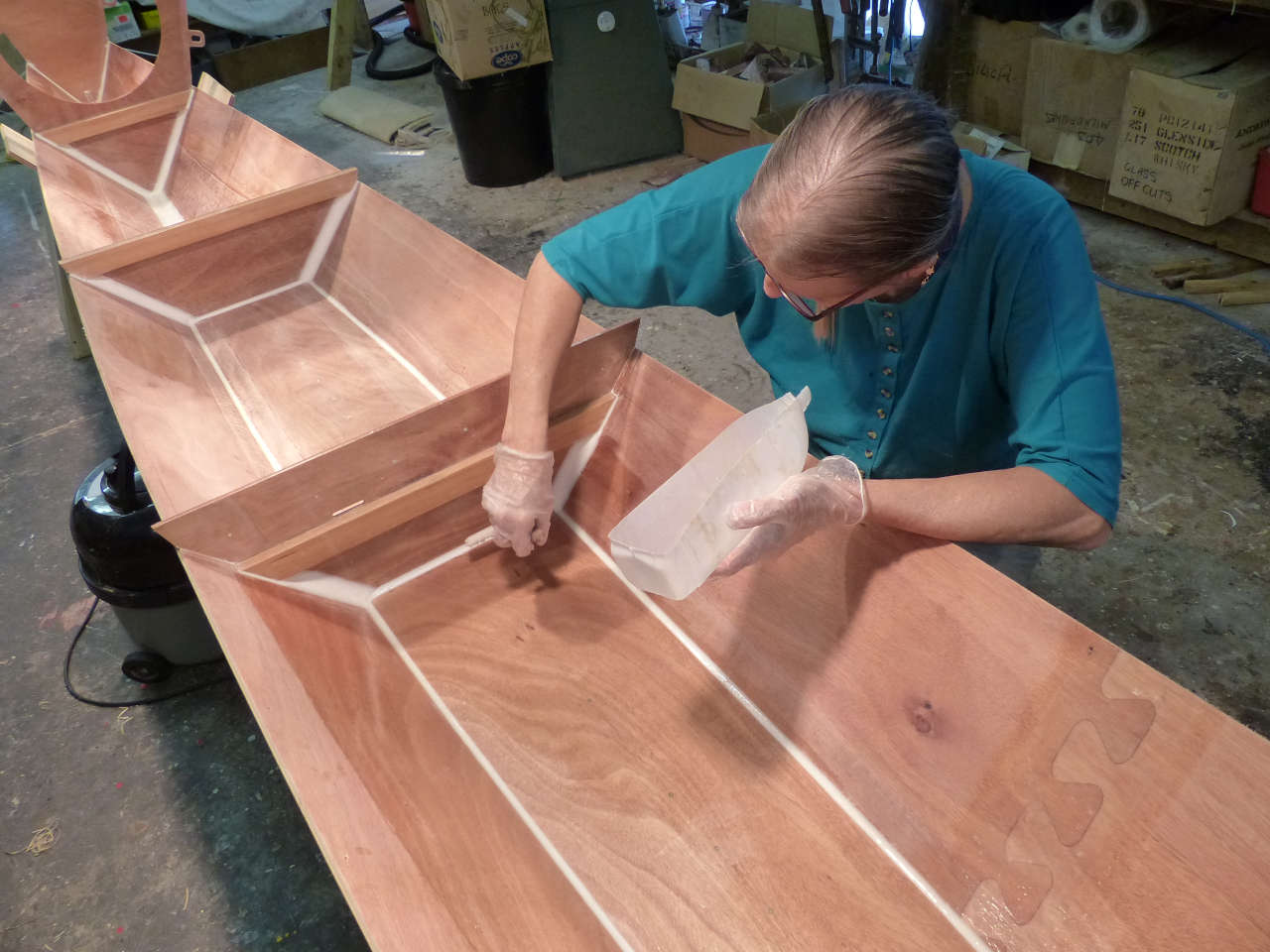
For speedy assembly the hulls and beams of the MANA are connected with quick-fit webbing straps with over-centre buckles, which are very strong and much easier to fit than bolts.
With the main mast of the MANA placed well forward the platform gives ample flat space for a low cost dome tent or a custom-made pramhood tent, which can double as spray hood when sailing. Adapting camping habits to a sailing lifestyle gives wider sailing opportunities at minimum cost and lots more family fun!
MANA uses the well proven Wharram Wingsail rig in a new Catrig configuration. The Wingsail rig is a modern version of a high aspect Dutch style gaff rig, sleeved round the mast for maximum aerodynamic efficiency.
In this new Catrig configuration the mainsail gives the drive with a very clean leading edge. The small mizzen aids with balance, steering and tacking . Having no jib, there is no need for a very tight forestay. The standing rigging uses the latest dyneema rope, which is light and easily set up. The mizzenmast can be used as sheer pole for single-handed assembly.

Mana 24 Design Data
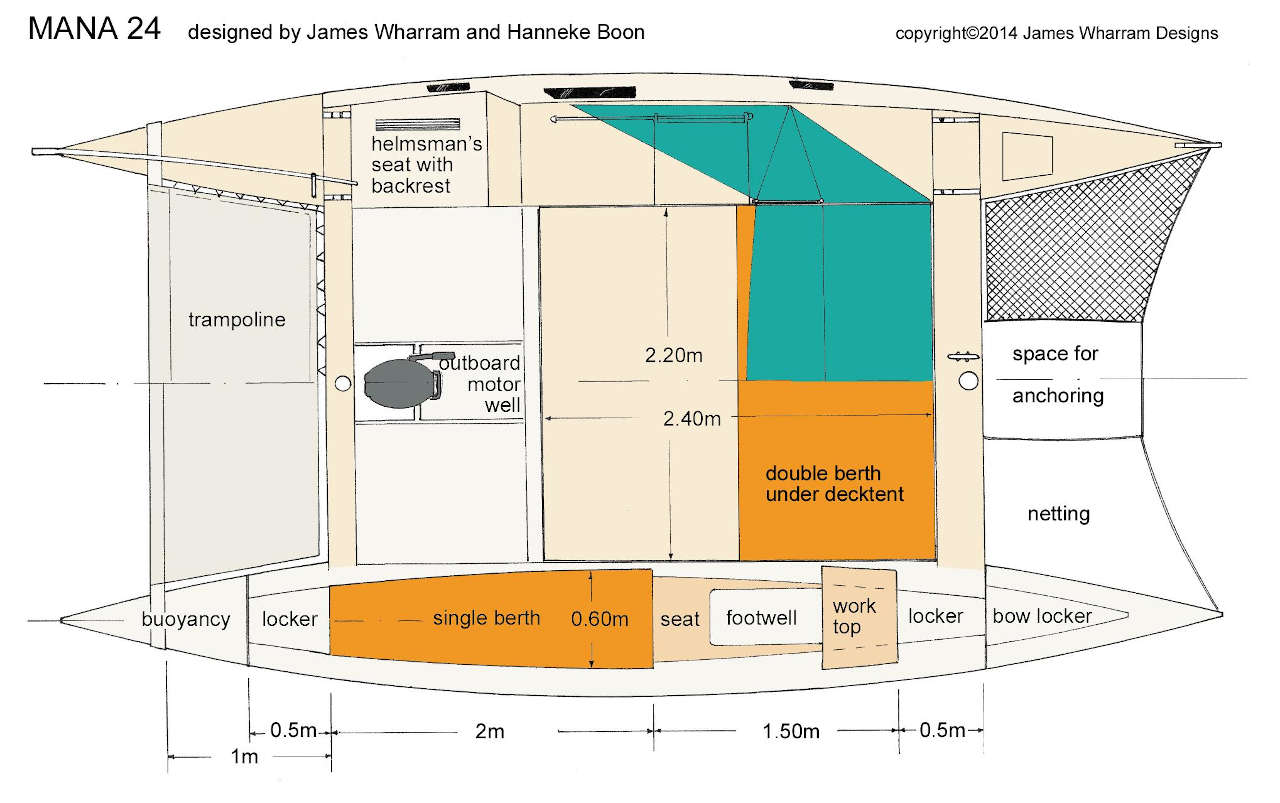
What You Get In A Mana Kit
CNC cut plywood parts, timber parts, epoxy materials, fastenings, ropes, blocks and fittings are all included in the kit. See the price list .
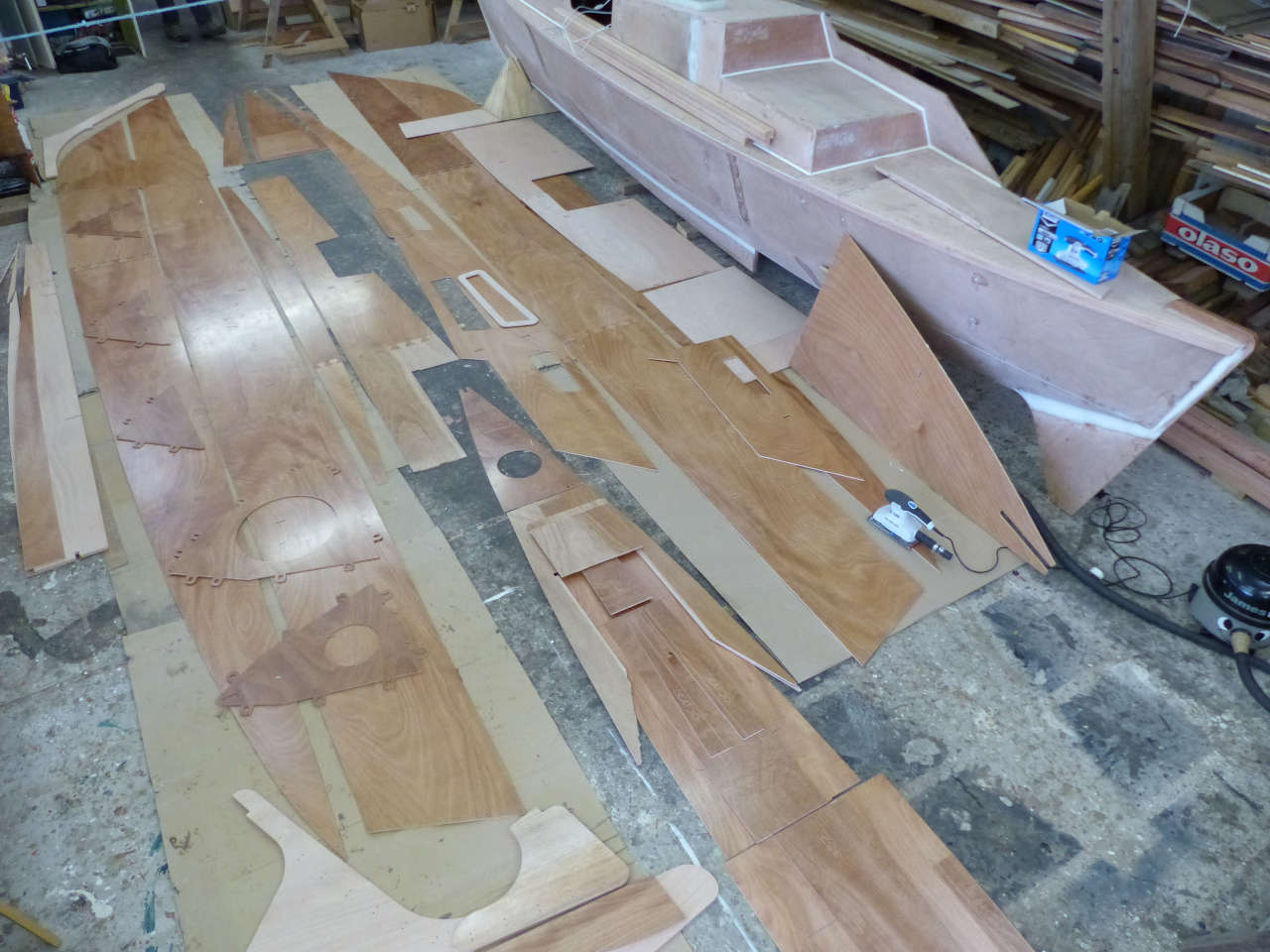
Transporting The Mana Kit
The entire kit can fit and be transported in the back of a van with ease. The van in the photos is a VW Transporter.

Boat In A Box
Your Mana 24 kit will arrive in a box like this!
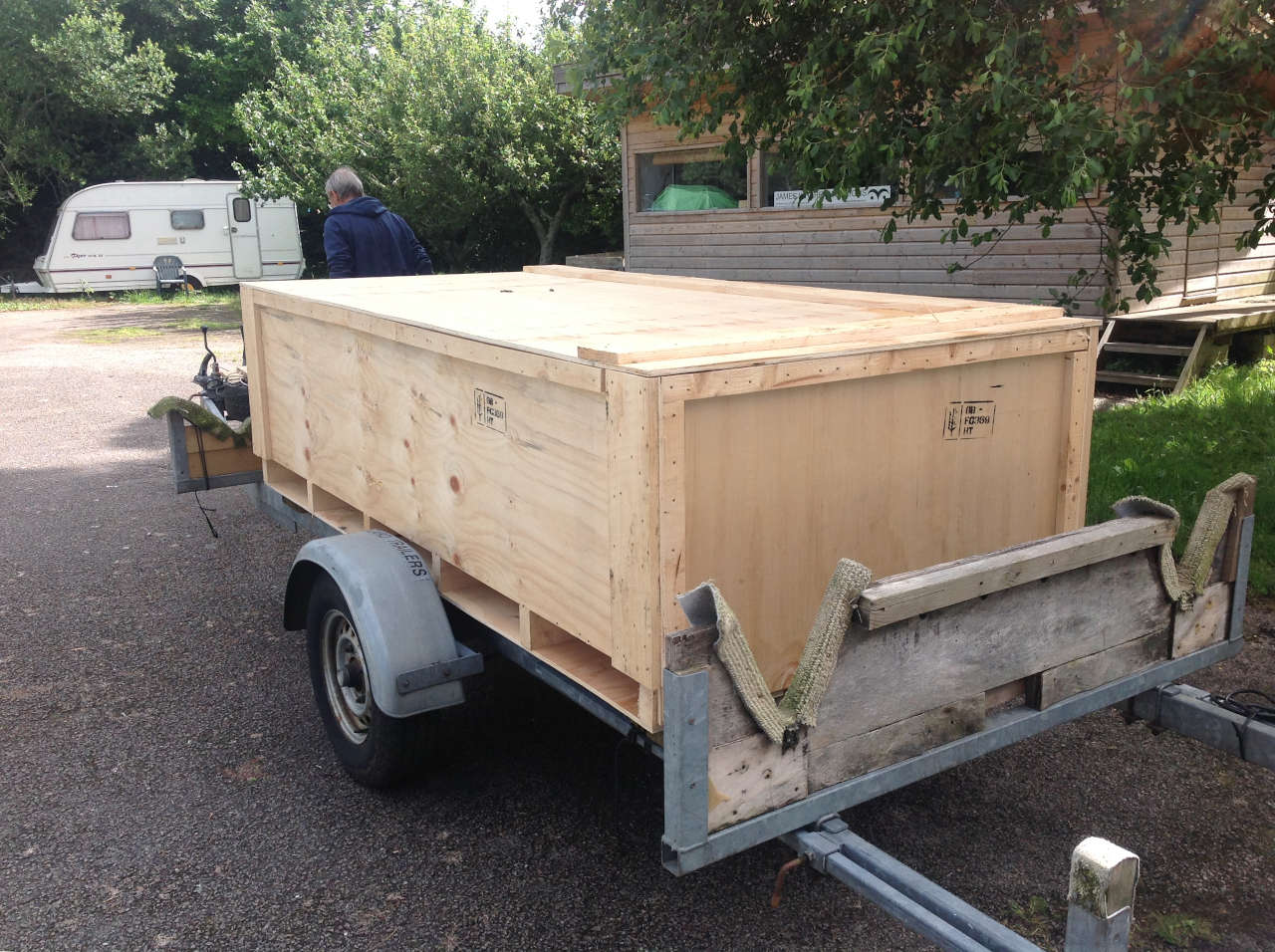
We're Taking Orders
The Mana 24 kit is now available and we are taking orders. We will be handling each order individually due to different options and shipping costs, so if you would like to discuss ordering a Mana kit, please contact us , we will then be able to work out shipping details to your building site and supply you with a pro forma invoice.
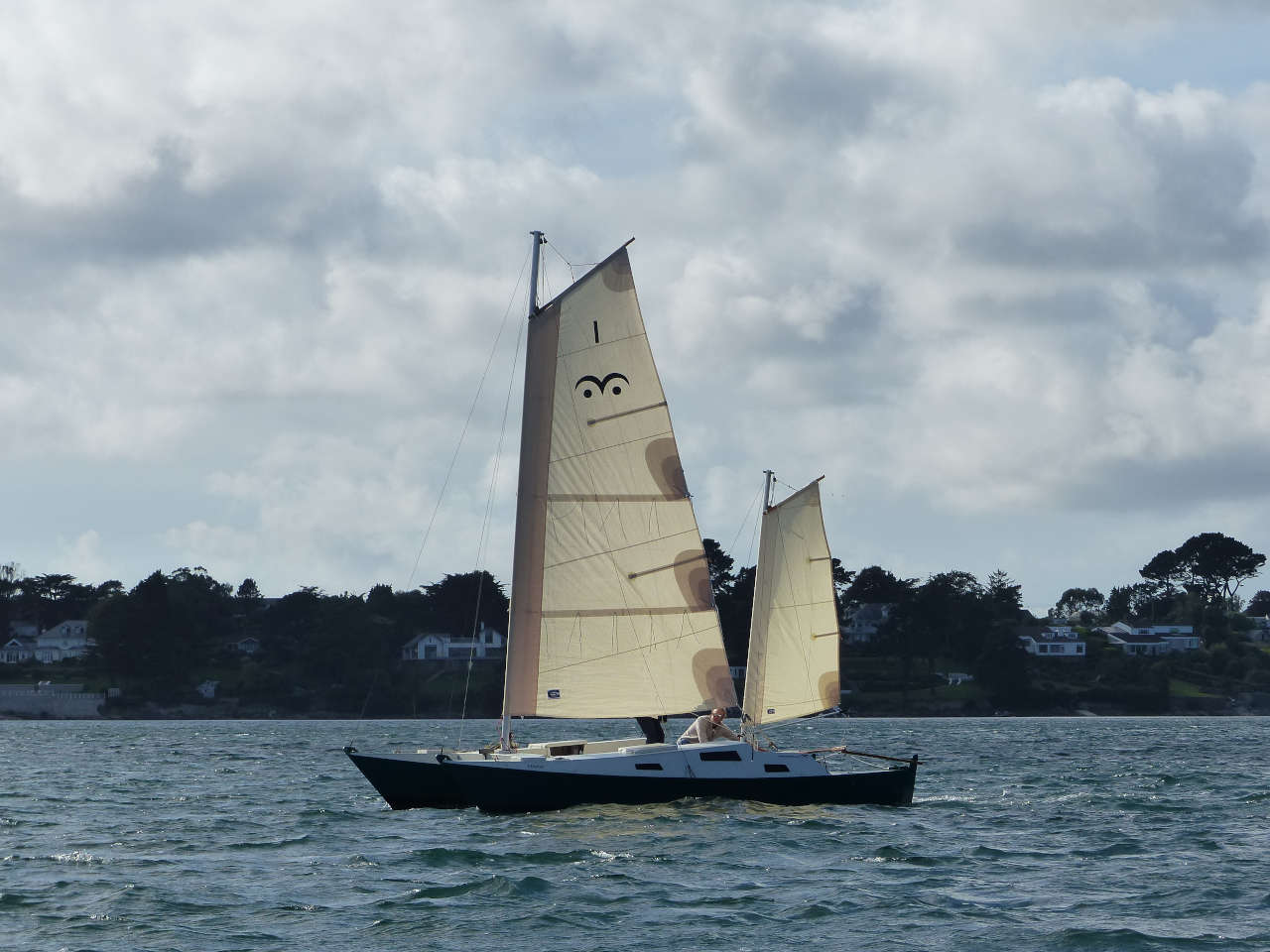
Cost of complete kit, including all fittings, masts and sails is £12,750 (if bought complete, separate costs below). All prices excluding VAT, and excluding shipping costs (shipped FOD, Freight on Delivery).
If your budget is tight, it is possible to buy the kit in two stages , buying masts, sails, rigging, ropes and fittings later. Or you can buy just the basic Boatbuilding Kit which includes the building rights and plans, and source fittings, rope and fasteners yourself as all are detailed in the plans.
1. Boatbuilding Kit - Total Cost £9,975
- Complete set of plywood parts to build two hulls, crossbeams and motorbox, CNC precision cut. All plywood Robbins Elite BS1088 Marine Plywood, guaranteed for 15 years, manufactured from selected Gaboon (Okoume) veneers throughout
- Platform panels, 2 large, 2 small, prefabricated from 40mm plastic honeycomb, glassed top and bottom
- Small hardwood timber parts, CNC cut to size, ready for final shaping, sanding and fitting
- Perspex windows and washboards, CNC precision cut
- WEST Epoxy kit, includes all resins * , pumps, fillers and glass cloth, mixing sticks, 1 box vinyl gloves, 1 rubber squeegee
- Sikaflex 295 for fitting windows
- Sikaflex 221 for bedding fittings etc
- Neoprene rubber for sealing hatches
- Rubber for padding beam mounts
- Gripfast nails, stainless steel machine screws, cable-ties and roller-sleeves (to be cut into paint/epoxy-pads), 2 paint-pad handles.
- Douglas Fir timber for stringers, framing etc and hardwood for hatch coamings (mahogany) and keel strips (iroko), all in long lengths to be cut to size by builder *
* N.B. For overseas customers Boatbuilding Kit should be bought excluding the long lengths of Douglas Fir and hardwood timber for easier transport. Cost deducted by £1100. We can also not include the epoxy resin and hardener as these are hazardous products with freight restrictions. You will need to buy these through your local dealer. Cost for these deducted by £900. (i.e. Cost of Boatbuilding kit excl. long timber and epoxy £7,975).
2. Blocks, Fittings And Rope Kit - Total Cost £1,200
- All blocks, cleats, shackles and other fittings to rig the Mana
- All ropes for sheets, halyards, lanyards and standing rigging (Dyneema)
- Stainless steel buckles and webbing straps for crossbeams
- Shockcord for tillers and hatches
- Aluminium boathook/mizzen boom
- Set of fittings for both mastheads and hinging unit for base of main mast, fabricated from aluminium and stainless steel
3. Sails, Made By Jeckells Of Wroxham - Total Cost £1,530 (Specify Colour)
- Mainsail with two reefs
- Mizzen with 1 reef
4. Masts * - Total Cost £510
- Aluminium mast tubes. 4 ½” OD x 10swg for main mast, 2 pieces @ 5m and 2.30 long, plus sleeve. 3” OD x 10swg for mizzen, 4m long.
* N.B. For overseas customers we suggest you source your mast tubes locally as shipping long lengths will be costly.

Building Time Estimate
We kept precise building hours while building the prototype. We built to a high quality standard with excellent finish, i.e. a lot of time spent on precision sanding, fairing etc. Building time in the early stages of building is greatly reduced by the CNC cut plywood parts, which takes away all the worry of measuring and cutting and lets the builder assemble the hulls very quickly.
Summing Up Of The Times We Took
- All construction work; hulls, beams, gaffs, tillers, hatches, including epoxy coating all interior surfaces: approx. 500 hours
- All exterior glassing work; hulls and crossbeams: 90 hours
- All sanding of glassed surfaces: 45 hours
- Painting, two coats epoxy primer, two coats 2-pack topcoat incl. non-slip decks and antifouling: approx. 80 hours
N.B. What should be noted is how many hours it takes to do sanding and painting compared to the building time. Glassing, sanding, fairing and painting add up to 30% of the total building time. On our basic building time estimates in our Design Book, final finishing and painting are not taken into account. Working from a kit does save many hours.
Transport Sizes And Weights
- The plywood kit, including made-up platform panels will be in labeled bagged bundles measuring in total approx. 2.5m x 1.20m x 0.3m and weighs around 300kg
- Fastenings, blocks, fittings and ropes, 1 box, approx. 60 x 40 x 30cm . Weight 25kg
- The WEST epoxy kit measures approx. 1.3m x 0.6m x 0.45m and weighs around 100kg
For overseas transport the above items have to be packaged in one special wooden pallet crate - 2.62m x 1.29m x 0.77m - at additional cost of £250.
- Timber will be a long parcel (around 3.5m - 4m long) and will weigh around 50-60kg
- Aluminium masts, in max. 5m long sections , weight incl. fittings 40kg
For overseas customers we advise them to source the timber and masts locally.
You will be able to collect the complete kit from Cornwall, UK yourself on a trailer or in a van saving on a lot of shipping costs and paperwork.
Interested in building a Mana? Contact us now:
Max Innovation
The straight line between performance and comfort..
Welcome to Max Cruise Marine. We are a specialist multihull production company with over six decades of combined boat-building experience. After many years in the industry we started our company based on a simple question: “How do we give our clients a sailing experience that combines the best of both worlds, performance and comfort? How do we empower our clients?” Our answer – options; from the interior layout and finishes, to performance enhancements and build type (self-build or professional), as well as international build location.
Our discerning clientele appreciates the balance we achieve between cruising performance and comfort. For us, performance means blending speed and safety, while taking into account factors such as efficiency of moving about the boat. Comfort, on the other hand, means never compromising on the features you need to enjoy your time aboard – while ensuring you arrive safely and on time. In short, our designs draw a straight line between performance and comfort.
All our models are the result of a single-minded objective – to fuse design innovation with cutting-edge technology and hands-on experience. Constructed with vacuum infused foam cored, carbon reinforced laminates. Current leaders in cruising Hybrid Sail Catamarans, Whatever your requirements our agents will be able to answer your questions and provide step-by-step sales support. We look forward to your enquiry. For USA Clients please contact [email protected] or [email protected]
Or contact Max Cruise Marine. [email protected]
Why Choose Max Cruise Marine?
With so much choice in the boat building arena it makes good sense to decide upfront what utility and features you want from your multihull. if you’re looking for a best-in-class innovative blend of sailing performance and cruising comfort then max cruise marine should be your final port of call. we offer:, max quality; max performance; max comfort; max value, fast-tracked, affordable builds anywhere in the world, self-build option using our 3d modular (3dm) moulded sets – delivered worldwide, boats professionally built near you or in our vietnam build yard, moulded exterior with gelcoat finish plus cnc-cut interior (choice of three options), variety of helm, propulsion, sail plan and interior design options, our design philosophy, innovation and efficiency are at the heart of our design ethos – from the materials and build methods (3dm) we use, to the mindful creation of space, weight distribution and performance optimisation. our design and production techniques enable us to offer extremely high-quality builds at very competitive price points., max cruise marine design features include:.
Largest saloon / cockpit in class
- Perfect sightlines and 360° degree visibility
Choice of multiple layouts with generous spacing and flow
High quality finishes
Multiple helm options
Multiple propulsion options
Multiple rig options
Charter cruising and performance cruising options
Asymmetric hulls with reserve buoyancy
Centrally balanced construction – lightweight bows and stern
Max Quality Materials
All Max Cruise Marine multihulls are precision built using light, strong, high-quality materials, featuring:
3D panels are made from Vinylester resin-infused structural PVC foam core
Gelcoated exterior
Fully moulded 3D exterior
Optimized laminate orientation
CNC (Computer Numerical Control) precision-cut interior
- Where do I start?
- Catamaran Designers
- Bridgedecks & Turret
- Cockpit & Steering
- Hulls, Frames, Plinths & Anchor
- Top Coat
- Winches and Mast
- Our Books
- Our Videos
- Terms of Use
- Contact Us
building a catamaran
A collection of sailing catamaran building logs, from sailboat plans to yacht launch. This 11.6m 'EASY Series' catamaran, joining other catamarans to lat and longs unknown...join us on our journey
Scroll down this page to read more...
Plywood and Epoxy Catamaran
This 'glass-over-ply' sailboat is proof that a DIY'er can successfully build an ocean-going multihull. Plywood construction is the cheapest building method available and very forgiving while one hones their skills. Finishing with a solid fiberglass outer is also a task made easier, given the amount of glassing and gluing needed during such a project.
It will soon become evident that parting with a few dollars provides a strong foundation for your catamaran building decisions. Having reliable Boatbuilding Resource Books , WILL HELP fast track your decisions prior to, during and post building.
We also wanted a light sailing catamaran that we could beach with ease. This now allows us to save money on one of the biggest maintenance DIY chores, sailboat antifouling without having the costly expense of slipway fees.
Keep scrolling...
how to build a boat.
"it takes a strong desire and a will to achieve. building a large catamaran is achievable".
Our build in 3-minutes

Many sailboat plans to choose from.
Is it cheaper to build or buy.
There are many yacht plans to choose from, but dont kid yourself. Many have tried to do it on the cheap and their result shows.
If there was a cheaper way, the sailboat designers would tell you. Afterall, they would use that reason to sell there plans!
If you want a yacht with all 'bells and whistles', keep working because it does cost money.
Enough waffle, jump into the website and have fun


Catamaran Sailing
DIY boat projects on Pure Majek from new navigation equipment, anchoring systems, rewiring yacht electronics diagrams, AIS and much more. We carry updates and rate products such as antifoul, solar fans and even galley items.
Its been ten great years since launch and we look at things that have worked and those we would change.
Join us and be inspired.
Welcome to sailboat planning and building.
Setting achievable goals and how to stick to them. From the planning process, what and why we did many things, importantly, things we would do differently. The following pages draw on these experiences described in far more detail in our book 'A Sailing Catamaran Building Adventure'
Important Information Terms of Use located in 'ABOUT US'
© 2024 www.diycatamaran.com All Rights Reserved

Mastering Catamaran Sailing: Essential Guide & Tips to Navigate the Waters
Alex Morgan
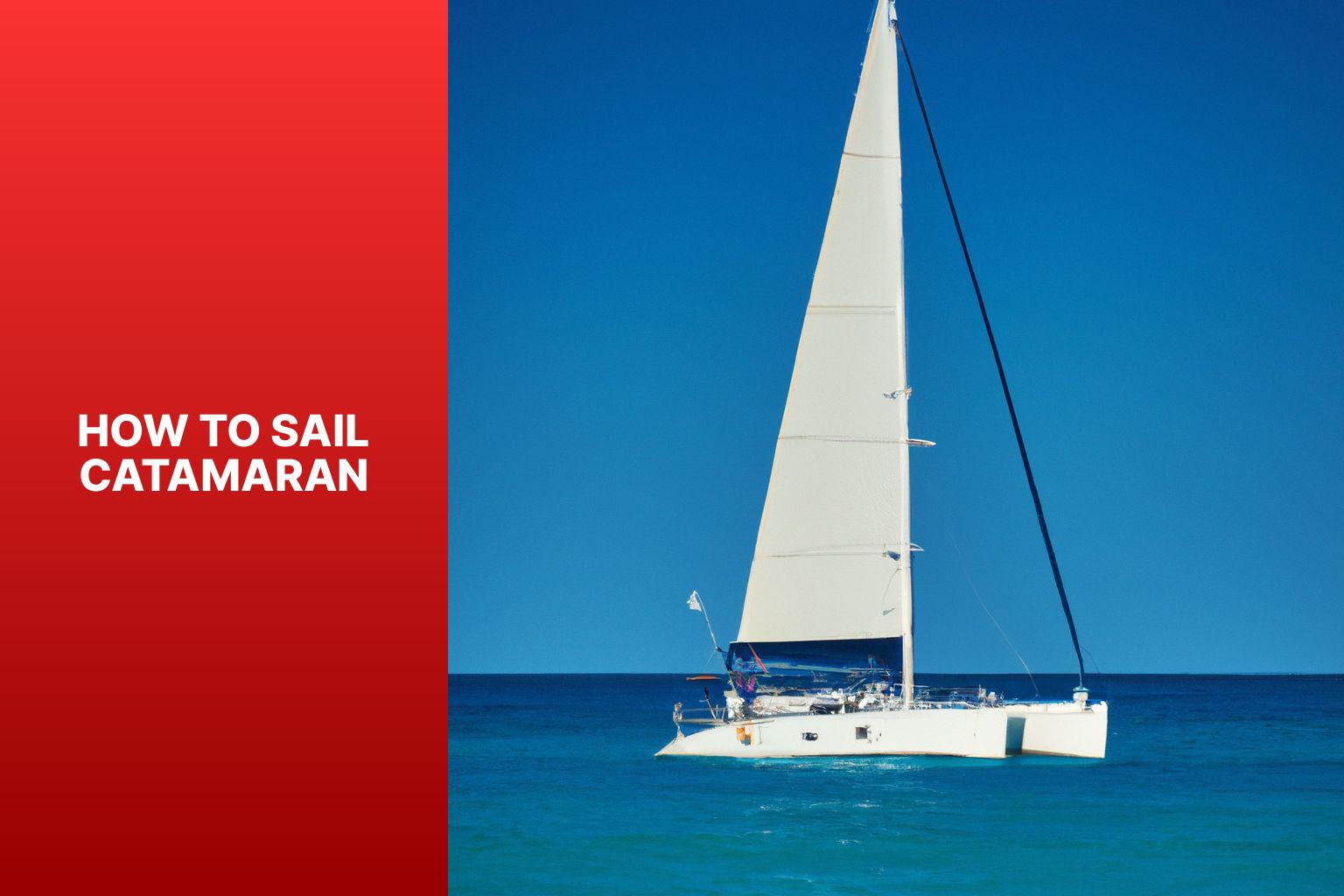
Sailing a catamaran can be an exhilarating and enjoyable experience for both experienced sailors and beginners alike. Unlike monohull sailboats, catamarans offer unique advantages in terms of stability and speed. If you’re interested in learning how to sail a catamaran, it’s important to understand the basics and master the necessary skills. This article will provide you with a comprehensive guide to sailing a catamaran, from understanding the fundamentals to maneuvering and handling the boat effectively.
To begin with, let’s delve into the introduction of sailing a catamaran, followed by understanding the basics of a catamaran. We’ll explore what exactly a catamaran is and how it differs from a monohull sailboat. we’ll discuss the advantages of sailing a catamaran, highlighting why it has become a preferred choice for many sailors.
Before setting sail, proper preparation is essential. This section covers the importance of safety equipment and checks, along with understanding wind and weather conditions. Planning your route is crucial to ensure a smooth and enjoyable sailing experience.
Once you’re prepared, we’ll move on to the essential sailing techniques for a catamaran. This section will guide you through rigging and hoisting the sails, tacking and jibing, trimming the sails, and controlling speed and direction. Mastering these techniques is key to maneuvering the catamaran effectively on the water.
Handling the catamaran also requires specific techniques. We’ll cover important maneuvers such as docking and undocking, mooring and anchoring, and addressing emergencies like man overboard recovery. These skills are vital to ensure a safe and successful journey.
We’ll provide you with essential safety tips for sailing a catamaran. Understanding right-of-way rules, handling rough seas and heavy winds, and maintaining balance and stability are crucial aspects of staying safe on the water.
By the end of this comprehensive guide, you’ll have a solid understanding of how to sail a catamaran and be well-equipped to embark on your own catamaran adventures while ensuring a safe and enjoyable experience.
– Sailing a catamaran offers the advantage of maximizing space with its two hulls, allowing for more comfortable living quarters and a larger deck area. – Catamarans provide a stable and balanced sailing experience, making them a safer option for beginners and those prone to seasickness. – Proper preparation, including checking safety equipment, understanding weather conditions, and planning your route, is crucial for a successful catamaran sailing experience.
Understanding the Basics of a Catamaran
Understanding the basics of a catamaran is essential for safe and enjoyable sailing. A catamaran is a boat with two parallel hulls connected by a deck. It has advantages over monohull boats. Catamarans are stable due to their wide beam, reducing the risk of capsizing . They can access shallow waters because of their shallow drafts . Catamarans also offer more space and comfort with larger cabins, living areas, and deck space.
To control a catamaran, the skipper uses the helm to control the rudders. Adjusting and trimming the sails allows the skipper to use the wind’s power and steer the boat efficiently. Balancing the sails and maintaining stability while sailing is important.
Knowing the key components, how to control the boat, and handle the sails will help you navigate the waters confidently. Whether you’re a seasoned sailor or a beginner, familiarizing yourself with the fundamentals of catamarans is crucial.
What Is a Catamaran?
A catamaran, also known as a cat , is a type of boat that features two parallel hulls connected by a platform or bridge deck. This unique design provides it with stability and speed, making it a popular choice for sailing enthusiasts. Unlike traditional monohull sailboats, a catamaran offers a wider beam , which results in more space and greater stability . As a result, the sailing experience on a catamaran is smoother and more comfortable .
There are several advantages to sailing a catamaran. One significant advantage is its shallow draft , which allows it to navigate in shallower waters that are inaccessible to other types of boats. The dual hull design of a catamaran minimizes drag and enhances speed , making it highly efficient for long-distance cruising . The spacious interior layout of a catamaran provides ample room for accommodations , amenities , and storage .
When sailing a catamaran, it is essential to consider the wind and weather conditions for safe navigation. Understanding the right of way rules and knowing how to handle rough seas and heavy winds are crucial skills for catamaran sailors. Maintaining balance and stability is of utmost importance to ensure a smooth sailing experience.
A fun fact about catamarans is that they have been utilized by Polynesian cultures for centuries, proving their effectiveness and versatility in various sailing conditions.
How Is a Catamaran Different from a Monohull Sailboat?
A catamaran is different from a monohull sailboat in several ways. A catamaran has two parallel hulls connected by a deck or bridge, whereas a monohull sailboat only has one hull. This dual hull design provides greater stability and balance on the water.
In addition, the hulls of a catamaran are wider and shallower compared to those of a monohull, allowing for a shallower draft and improved maneuverability . This also results in a higher cruising speed and faster sailing speeds for catamarans.
Catamarans also offer more interior space and are known for their spaciousness and comfort , thanks to their wider beam. When sailing upwind, catamarans experience less heeling , which translates into a smoother and more comfortable ride for passengers.
Catamarans are better suited for cruising in shallow waters and can anchor closer to shore due to their shallow draft . The dual hull design of catamarans also provides greater redundancy and safety in the event of hull damage or collision.
Unlike monohull sailboats, which typically have a keel, catamarans rely on centerboards or daggerboards to prevent sideways sliding. The main differences between a catamaran and a monohull sailboat lie in their stability , speed , comfort , and maneuverability .
Advantages of Sailing a Catamaran
– Stability: Catamarans offer excellent balance with their twin hulls, making them less likely to tilt or capsize compared to monohull sailboats.
– Spaciousness: The wide beam of catamarans provides more interior and deck space, including comfortable living quarters, larger cabins, and ample room for socializing and entertaining.
– Speed: The design of twin hulls reduces drag, allowing catamarans to sail faster and provide exhilarating experiences.
– Shallow Draft: Catamarans have a shallower draft than monohull sailboats, enabling them to sail in shallower waters and access a wider range of cruising grounds.
– Comfort: The wide beam and stable design of catamarans offer a smoother and more comfortable sailing experience, eliminating the heeling common in monohull sailboats and reducing the chances of seasickness.
– Maneuverability: Catamarans are more maneuverable than monohull sailboats, providing better turning ability for navigating tight spaces, docking, and anchoring precision.
– Sailing Performance: Catamarans excel in light wind conditions, thanks to their large sail area and light weight, allowing them to catch even the slightest breeze and maintain good boat speed. This makes them ideal for destinations with calm weather patterns.
Preparing for Sailing a Catamaran
Preparing for a thrilling catamaran sailing adventure requires careful planning and essential knowledge. As we dive into the section on “ Preparing for Sailing a Catamaran ,” we’ll explore vital aspects such as safety equipment and checks , understanding wind and weather conditions , and planning your route . Get ready to uncover expert tips and strategies to ensure a smooth and enjoyable catamaran journey on the open waters.
Safety Equipment and Checks
Prioritize safety when sailing a catamaran. Thoroughly check and prepare your safety equipment before setting off on your adventure. Consider the following important safety equipment and checks :
- Life jackets: Ensure enough properly fitting life jackets for everyone on board.
- Flotation devices: Have throwable flotation devices readily available for emergencies.
- Fire extinguishers: Have the appropriate type and number of fire extinguishers on board.
- First aid kit: Maintain a well-stocked kit for handling minor injuries or medical emergencies.
- Navigation lights: Ensure all navigation lights are functioning properly, especially for sailing at night or in low visibility conditions.
- Communication devices: Carry reliable communication devices such as a marine VHF radio or satellite phone for calling for help if needed.
- Engine and safety equipment checks: Regularly inspect engines, bilge pumps, anchor systems, and other safety equipment to ensure good working condition.
Remember, safety is crucial. Check your safety equipment before every trip and ensure proper working order. Familiarize yourself with specific safety requirements and regulations of the sailing area. By taking these precautions, you can enjoy your catamaran sailing adventure with peace of mind and be prepared for any unexpected situations.
Understanding Wind and Weather Conditions
Understanding wind and weather conditions is crucial when sailing a catamaran. You must have a comprehensive understanding of the wind direction, speed, and weather changes that may impact your sailing experience. Here are some key considerations to keep in mind:
1. Wind direction: It is essential to know the direction from which the wind is blowing. This knowledge will assist you in planning your sailing route and selecting the appropriate sails.
2. Wind speed: Pay close attention to the wind speed as it could potentially affect the speed and maneuverability of your boat. Higher wind speeds may necessitate reefing the sails or adjusting your course.
3. Weather changes: Remain mindful of any approaching storms, rain, or fog. These conditions can have a significant impact on visibility and create challenges when sailing.
4. Sea state: Take note of the current sea state, which includes wave height and frequency. Rough seas may require you to adjust your sailing technique and speed to ensure the stability of the catamaran.
5. Weather forecasts: Always remember to check the weather forecasts before embarking on your sailing trip. This will provide you with an overview of the expected weather conditions.
By possessing a thorough understanding of wind and weather conditions, you can make well-informed decisions to ensure a safe and enjoyable sailing experience aboard a catamaran. Keep in mind that conditions at sea can change rapidly, so it is essential to stay vigilant and adapt your plans accordingly.
Planning Your Route
When planning your catamaran sailing route, it is important to consider several factors for a safe and enjoyable journey. One of the first things to do is assess the weather conditions by checking the forecast for potential storms or strong winds. It is crucial to avoid adverse conditions as they can pose risks to both the crew and the catamaran’s safety.
In addition, it is necessary to identify key destinations and conduct research on navigational challenges. This will help in finding suitable anchorages or marinas along the way. Creating a timeline is also essential to plan the duration of the journey, taking into account the distance to be covered and the catamaran’s speed. It is important to remember to account for any time constraints or events that may affect the plan.
Using navigational charts, it is advisable to plot the course, noting any potential obstacles along the way. It is also a good practice to plan alternative routes in case they become necessary. Considering currents and tides is another crucial aspect of route planning. Studying tidal patterns and current directions will allow for incorporating these factors into the planning process for greater efficiency.
Another important consideration is fuel and provisions . It is necessary to determine the locations of fuel stations and provisioning points along the route. Planning fuel stops and stocking up on supplies will ensure that you have everything you need during the journey. Communication and safety should not be overlooked either. Identifying channels to communicate with other sailors and emergency assistance is vital . It is also important to familiarize yourself with emergency procedures and have access to contact information in case of any unforeseen circumstances.
It is recommended to regularly review your route plan and make adjustments based on real-time conditions and feedback. This will help ensure that you are always up to date with any changes that may occur during the journey. By carefully planning your route, you can optimize your sailing experience, safely navigate waters, and fully enjoy your catamaran adventure.
Essential Sailing Techniques for Catamaran
Mastering the essential sailing techniques for a catamaran is the key to harnessing the power of wind and water. From rigging and hoisting the sails to controlling speed and direction, each sub-section in this guide will unlock the secrets that seasoned sailors swear by. So, get ready to tack and jibe , trim those sails just right, and experience the exhilaration of sailing a catamaran like a pro!
Rigging and Hoisting the Sails
To rig and hoist the sails on a catamaran, follow these steps:
1. Assemble the mast, boom, and rigging securely and properly aligned.
2. Attach the main halyard securely and tensioned to the head of the mainsail.
3. Attach the jib halyard properly tensioned and secured to the head of the jib sail.
4. Connect the main sheet to the boom to control the angle and tension of the mainsail.
5. Connect the jib sheets to the clew of the jib sail to control the angle and tension of the jib sail.
6. Attach the reefing lines to the mainsail, if applicable, to reduce sail area in strong winds.
7. Check all rigging and lines for proper tension and adjustments, ensuring everything is secure and aligned.
8. Raise the mainsail by pulling on the main halyard while guiding the sail up the mast, using winches or other mechanical aids if necessary.
9. Raise the jib sail by pulling on the jib halyard while guiding the sail up the forestay, using winches or other mechanical aids if needed.
10. Adjust the main sheet and jib sheets to achieve the desired sail shape and trim for optimal boat performance.
Rigging and hoisting the sails on a catamaran is crucial for a smooth and exhilarating sailing experience. By following these steps, you can confidently prepare your catamaran for sailing adventures.
Now, let’s appreciate the history of rigging and hoisting sails. Sailing has been a vital mode of transportation and exploration for centuries. The technique of rigging and hoisting sails has evolved from simple square sails to more efficient and versatile fore-and-aft sails used on catamarans. Today, catamarans are equipped with advanced rigging systems and modern materials that enhance speed and maneuverability. Rigging and hoisting sails remain a vital skill for sailors, connecting us to our seafaring ancestors and enabling exploration of the world’s oceans with grace and agility.
Tacking and Jibing
Tacking and jibing are essential maneuvers when sailing a catamaran. These techniques allow you to change direction and make the most of the wind. Consider these key points:
- Tacking: This maneuver is used to sail against the wind. Turn the bow of the boat through the wind to switch the sails to the opposite side. This allows you to zigzag towards your destination.
- Jibing: Use this maneuver to change direction with the wind at your back. Turn the stern of the catamaran through the wind to move the mainsail to the other side. Control the boom to prevent dangerous swinging.
- Preparation: Before tacking or jibing, ensure that the crew is aware and in a safe position for stability during the turn.
- Wind direction: Success with tacking and jibing depends on understanding the wind. Assess the wind and plan your maneuvers accordingly.
- Practice: Perfecting tacking and jibing requires practice. Start with gentle maneuvers in light wind conditions and gradually progress with experience.
During a sailing race, a crew utilized their knowledge of wind patterns and executed a flawless maneuver by tacking right before the finish line. This tactical advantage secured their victory.
Trimming the Sails
Sailing a catamaran requires mastering the skill of trimming the sails . Properly trimmed sails greatly impact the catamaran’s performance and maneuverability. Here are some important considerations for sail trimming:
1. Adjusting the tension: Properly adjusting the tension on the sails is vital for achieving the desired shape and angle. The main sail should have a slight curvature called camber , which generates lift and power. Trim the jib sail to maintain smooth airflow on both sides.
2. Controlling the angle: The angle of the sails in relation to the wind direction is crucial for maintaining optimal speed. Adjust the sheets to trim the sails closer or further from the wind based on sailing conditions and desired speed.
3. Monitoring the telltales: Telltales , small yarn or ribbon pieces attached to the sails, provide valuable airflow information and indicate proper sail trimming. Continuously observe the telltales to ensure smooth and even flow.
4. Reefing: In strong winds, reducing the size of the sails through reefing is necessary to maintain stability and control. Follow the manufacturer’s guidelines for reefing and ensure proper securing of the sails.
5. Constant adjustment: Sail trimming requires constant attention. Continuously monitor wind conditions and make necessary adjustments to optimize performance and maintain control.
Mastering the art of sail trimming leads to smoother sailing, improved speed, and enhanced overall performance on a catamaran. Practice and experience are essential for developing this skill, so head out to the water and start honing your sail trimming abilities.
Controlling Speed and Direction
To effectively control the speed and direction of a catamaran, it is important to follow these steps:
1. Sail Adjustment: Optimize the power and speed of the catamaran by trimming the sails. Utilize the mainsail and jib sheets to manipulate the sail angle, taking into account the wind direction.
2. Utilize the Traveler: Fine-tune the speed and stability by adjusting the traveler. This tool, located across the cockpit, allows you to modify the mainsail sheeting point and control the angle of the mainsail.
3. Sail Plan Modification: Alter the sail plan as necessary to either increase or decrease speed. Reef the sails in strong winds to reduce the sail area, and unreef them in light winds to allow for greater sail area.
4. Daggerboard Adjustment: Maintain stability and control the direction of the catamaran by raising or lowering the daggerboards. These adjustments contribute to achieving balance and maneuverability.
5. Rudder Tweaking: Make slight adjustments to the rudder angle using the tiller or wheel, ensuring smooth steering of the boat.
Pro-tip: Enhance your ability to control speed and direction on a catamaran through practice and experience. Continuously monitor wind conditions and make minor adjustments to optimize performance.
Catamaran Maneuvers and Handling
Get ready to conquer the waters as we dive into the art of sailing a catamaran. In this section, we’ll navigate through the thrilling aspects of docking and undocking , the essentials of mooring and anchoring , and the crucial skill of man overboard recovery . Brace yourself for a wave of practical tips and tricks that will enhance your catamaran sailing experience. So, grab your compass, adjust your sails, and let’s set sail on this exciting journey!
Docking and Undocking
Docking and undocking a catamaran can be daunting, but with the right techniques and precautions, it can be done smoothly. Follow these steps:
- Approach the dock slowly, keeping an eye on the wind and current.
- Assign crew members to handle lines and fenders for a safe docking process.
- Shift into reverse as you near the dock to slow down.
- Turn the helm to steer the catamaran parallel to the dock as you stop.
- Have crew members ready with fenders to protect the catamaran.
- Engage reverse to back closer to the dock, using brief forward bursts to maneuver if needed.
- Once close, crew members should step off the catamaran with lines to secure it to the dock.
- Secure the catamaran using docking lines , ensuring they are properly fastened and have enough slack.
True story: One summer, while docking our catamaran in a busy marina, a strong gust of wind made our docking process challenging. Thanks to our crew’s quick reflexes and knowledge, we maneuvered the catamaran safely and secured it to the dock without damage. It was a valuable lesson in being prepared for unexpected situations while docking and undocking a catamaran.
Mooring and Anchoring
Mooring and anchoring are integral skills when sailing a catamaran. It is important to consider several key points when engaging in these activities. Make sure to choose the appropriate anchor that matches the type of seabed you will be navigating. Inspect the anchor line thoroughly to ensure it is in good condition and securely attached. Next, carefully select a mooring spot in a protected area that offers solid holding ground. When approaching the mooring, take into account factors such as wind and current, and proceed slowly. To secure the boat, use mooring lines that are connected to cleats or deck fittings. Safeguard your boat from potential damage by utilizing fenders . Prioritizing safety and accounting for your boat’s unique conditions and requirements is crucial. By practicing these techniques, you can enhance your proficiency and guarantee a safe and enjoyable sailing experience.
Man Overboard Recovery
- Assess the situation: When facing a man overboard situation, it is important to stay calm and promptly evaluate the circumstances. Take into account the distance between the catamaran and the individual in the water, as well as any nearby hazards or obstacles.
- Alert the crew: Immediately inform the other crew members about the man overboard incident. This ensures that everyone is informed and prepared to provide assistance.
- Initiate the man overboard recovery process: Throw a life buoy or any floating object towards the person in the water, offering them something to hold onto. This will help keep them afloat during the recovery process.
- Turn the catamaran: Skillfully maneuver the catamaran to create a controlled loop or figure eight pattern around the individual in the water. This will slow down the vessel and facilitate their retrieval.
- Bring the person back on board: Once the catamaran is properly positioned, utilize a ladder, swim platform, or any available means to assist in bringing the person back on board. Assign crew members to provide support and ensure the individual’s safety throughout the recovery process.
- Monitor and provide medical assistance: After the person is safely back on board, promptly evaluate their condition and administer any necessary medical attention. Check for injuries, monitor vital signs, and administer first aid if needed.
Pro-tip: Conduct regular man overboard drills and practice recovery procedures with your crew to ensure that everyone is familiar with their respective roles and responsibilities. This will help reduce response time and enhance the likelihood of successfully recovering individuals in emergency situations.
Safety Tips for Sailing a Catamaran
Discover essential safety tips when sailing a catamaran in this section. From understanding right of way rules to dealing with rough seas and heavy winds, you’ll learn how to navigate challenging conditions with confidence. We’ll explore techniques for maintaining balance and stability, ensuring a smooth and secure sailing experience. So hop aboard and let’s dive into the world of catamaran sailing safety !
Understanding Right of Way Rules
Understanding Right of Way Rules is crucial for safe sailing. Follow these guidelines:
1. Sailboats have the right of way over powerboats. Be aware of your surroundings and give way to any sailboats in your path.
2. When encountering a vessel on your starboard side, yield and give them the right of way. Alter your course slightly to avoid a potential collision.
3. When overtaking another vessel, keep a safe distance and give them the right of way. Maintain a slow and steady speed to avoid creating a dangerous situation.
4. In narrow channels or crowded areas, vessels going uphill or against the current have the right of way. Yield to any vessels navigating in these challenging conditions.
5. Always be cautious and maintain a safe speed when crossing paths with other vessels. Slow down if necessary to ensure a safe passage.
By understanding and adhering to right of way rules, you can navigate the waters confidently and reduce the risk of accidents. Remember, safety should always be the top priority when sailing a catamaran.
Dealing with Rough Seas and Heavy Winds
Dealing with rough seas and heavy winds is crucial when sailing a catamaran. Here are tips to navigate challenging conditions:
1. Check the weather forecast before setting off. If rough seas and heavy winds are expected, consider delaying your trip or changing your route.
2. Ensure all crew members wear appropriate safety gear, such as life jackets and harnesses. Secure loose items on the deck.
3. Maintain a steady speed when encountering rough seas to keep the boat stable. Avoid sudden changes in direction or speed.
4. Adjust your sails by reefing to maintain control and prevent overpowering by strong winds.
5. Be cautious when navigating large waves. Approach them at a slight angle to minimize the risk of capsizing. Maintain a firm grip on the helm.
6. Be aware of the sea state. Avoid crossing large waves head-on; instead, cross them diagonally or at a slight angle.
7. Communicate effectively with your crew. Assign roles and responsibilities to ensure everyone is working together for safety and control.
In rough seas and heavy winds, safety should be the top priority. Stay alert, remain calm, and rely on your training and experience.
Pro-tip: Consider advanced sailing courses or consulting experienced sailors to enhance your skills and confidence in dealing with rough seas and heavy winds.
Maintaining Balance and Stability
Maintaining balance and stability is absolutely crucial when sailing a catamaran. It is important to ensure that weight is evenly distributed on both sides of the catamaran in order to achieve stability .
One way to accomplish this is by having passengers and crew members move to the opposite side when the wind picks up. Another key aspect of maintaining balance is properly trimming the sails to adjust their angle in response to wind changes. This helps to prevent excessive heeling and ensures stability .
Paying attention to the centerboards can greatly enhance stability . Deploying the centerboards can counterbalance the force of the wind and prevent tipping over.
Steering also plays a significant role in maintaining balance. It is crucial to steer steadily and in a controlled manner in order to keep the catamaran on course and avoid any imbalance.
It is important to be aware of weather conditions and understand how they can impact stability . When faced with heavy winds and rough seas, it is essential to adjust sailing techniques accordingly and make any necessary adjustments to maintain balance and stability .
Some Facts About How To Sail Catamaran:
- ✅ Sailing a catamaran requires adjusting to the different motion and sail trimming compared to monohull sailboats.
- ✅ Catamarans provide more space and stability compared to traditional monohull sailboats.
- ✅ Catamarans do not heel like monohulls, providing a less tiring sailing experience.
- ✅ Catamarans can sail in shallower places and prevent rolling in anchorage due to their lower drafts.
- ✅ The American Sailing Association (ASA) offers a specific course, ASA 114: Cruising Catamaran, to provide practical sailing skills and confidence when sailing a catamaran.
Frequently Asked Questions
1. how do i sail a catamaran.
Sailing a catamaran involves adjusting to its different motion and sail trimming compared to monohulls. You’ll need to take a sailing course or gather practical sailing skills to ensure confidence and enjoyment while sailing a catamaran. The American Sailing Association (ASA) offers the ASA 114: Cruising Catamaran course designed specifically for individuals with monohull cruising experience transitioning to catamarans.
2. What are the advantages of sailing a catamaran?
Catamarans offer numerous advantages over monohulls. They are more spacious, providing larger living areas above decks and expansive cabins located in the hulls. Catamarans are incredibly stable, making them ideal for longer voyages and providing maximum comfort and relaxation. They also have lower drafts, allowing navigation in shallow reef passages and anchoring closer to shore. Catamarans do not heel like monohulls, providing a more comfortable and less tiring sailing experience.
3. How can I charter a catamaran from The Moorings?
The Moorings offers innovative and top-quality catamarans for sailing vacations. To charter a catamaran from The Moorings, you can visit their website and access their charter resources. They are known for their exclusive access to Robertson & Caine catamarans, distinguished for their quality and comfort. There, you can find information on boat availability, reputation, and customer reviews to choose the right catamaran for your needs and preferences.
4. What is the ASA 114: Cruising Catamaran certification?
The American Sailing Association (ASA) offers the ASA 114: Cruising Catamaran certification. This certification is designed for individuals with monohull cruising experience who want to transition to catamarans. The course covers the advantages and disadvantages of multihull sailing, as well as practical sailing skills specific to catamarans. Obtaining this certification ensures that you have the necessary knowledge and skills to confidently sail a catamaran.
5. Are catamarans safe for offshore sailing?
Yes, catamarans are safe and stable for offshore sailing. They are designed to offer stability and comfort in various conditions. Catamarans have two independent hulls, making them less likely to sink completely. They also have duplicate navigation systems, including two engines and rudders, for onboard safety. Catamarans remain stable even in bad weather and do not capsize easily. Their advanced design and safety features make them a reliable choice for offshore sailing.
6. Can I sail a catamaran without previous sailing experience?
Sailing a catamaran without previous sailing experience is not recommended. It is essential to have some sailing knowledge and skills before attempting to sail a catamaran. Taking a sailing course, such as the ASA 114: Cruising Catamaran course, will provide you with the necessary skills and confidence to safely operate a catamaran. Spending time onboard and obtaining a sailing diploma or certification will ensure a better understanding of catamaran sailing fundamentals.
About the author
Leave a Reply Cancel reply
Your email address will not be published. Required fields are marked *
Save my name, email, and website in this browser for the next time I comment.
Latest posts

The history of sailing – from ancient times to modern adventures
History of Sailing Sailing is a time-honored tradition that has evolved over millennia, from its humble beginnings as a means of transportation to a beloved modern-day recreational activity. The history of sailing is a fascinating journey that spans cultures and centuries, rich in innovation and adventure. In this article, we’ll explore the remarkable evolution of…

Sailing Solo: Adventures and Challenges of Single-Handed Sailing
Solo Sailing Sailing has always been a pursuit of freedom, adventure, and self-discovery. While sailing with a crew is a fantastic experience, there’s a unique allure to sailing solo – just you, the wind, and the open sea. Single-handed sailing, as it’s often called, is a journey of self-reliance, resilience, and the ultimate test of…

Sustainable Sailing: Eco-Friendly Practices on the boat
Eco Friendly Sailing Sailing is an exhilarating and timeless way to explore the beauty of the open water, but it’s important to remember that our oceans and environment need our protection. Sustainable sailing, which involves eco-friendly practices and mindful decision-making, allows sailors to enjoy their adventures while minimizing their impact on the environment. In this…
[email protected]

Sailing Designs
Welcome to our selection of sailing designs. our design ranges differ from each other in different ways, below you will see a general summary of each series, and the main key design features of each., below you will find a list of pdf information documents written by the schionning team to assist with understanding the principles of our designs., if you'd like more information on making a design decision, we have a plethora of information available to prospective clients under our resources page and material and kit specifics can be found in the kit pages., motor choices & options, contact us for more info, mainsheet systems for schionning designs, weight in schionning designs, schionning sailing performance & tips, design comparison table.

The Arrow Series is the latest range of performance cruising catamarans from Schionning Designs. Utilising 100% flat panel construction means that the Arrow designs will be the fastest build, as there is no strip-planking or more time consuming techniques. The Series currently includes the Arrow 1200, 1200 Sports, 1280-S, Arrow 1360 and Arrow 1500.

Our G-Force range are our most performance-oriented designs, having taken over from the Waterline Series with new reverse bow styling.
The standard G-Force designs are ultra-slim lightweight racing machines, with the ‘C’ Cruising designs allowing a little additional weight-carrying though they must still be kept light.

Designed primarily as an efficient fast sailing cat with high bridgdeck clearance and chamfer panels to minimize slamming.
The Solitaire Series are serious blue water cruisers, capable of taking you around the world with high mileage daily runs in comfort and safety.
RADICAL BAY

The Radical Bay 800 has a simple hull form, with a vee section forward to stop slamming running aft to a flat exit to reduce hobby horsing.
The Radical Bay 1060 (coming soon) is the big sister to the Radical Bay 8000 with afew new features, however none have been built.
TRACER 1500Tri

The Tracer Series are a range of performance cruising trimarans combining the speed trimarans are known for, with internal volume and spacious accommodation to create the perfect cruising platform.
Available as a pre-cut kit with detailed CAD drawn plans, suitable for amateur and professional construction.
The first of the range, the 1500TRi (15.00 metres) is now released, with more to come.
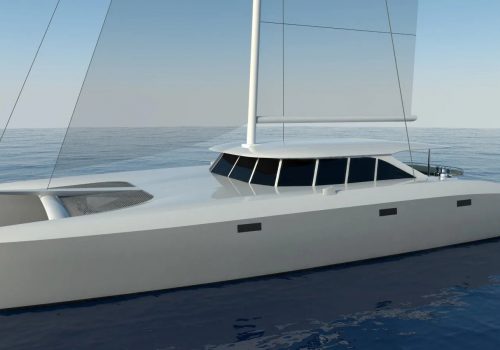
The Legend 60 is a cruising catamaran design encompassing some of the more classical design features that were requested from our clients.
The straight bow angles and vertical cabin window style gives her a distinct style, while staying true to her ocean greyhound heritage. The Legend 60 sits on the same hulls as the G-Force 1800 so she is still quite performance focussed.
TROUBLEMAKER

The Troublemaker 9500 is a small monohull trailer-sailor that is available in a complete kit including construction plans and pre-cut Duflex shell kit.
The Troublemaker is exceptionally easy to build compared with the multihulls, and estimates are under 1000 hours for a complete boat. She is offered with twin unstayed carbon masts that can be built yourself, or a standard alloy mast is an option.

The Ultimate Guide to Choosing Between a Sailboat or Catamaran for Your Sailing Adventures
C hoosing between a sailboat and a catamaran for your sailing adventures is a significant decision that depends on various factors, including your sailing preferences, experience level, budget, and intended use. Here's an ultimate guide to help you make an informed decision:
1. Sailing Experience:
- Sailboats: Typically require more skill and experience to handle, especially in adverse weather conditions. Ideal for sailors who enjoy the traditional feel of sailing and are willing to invest time in learning and mastering the art.
- Catamarans: Easier to handle, making them suitable for beginners. The dual-hull design provides stability, reducing the learning curve for those new to sailing.
2. Space and Comfort:
- Sailboats: Generally have a narrower beam and less living space. However, some sailboats may offer comfortable cabins and amenities.
- Catamarans: Wider beam creates more living space. Catamarans often have multiple cabins, spacious saloons, and expansive deck areas, providing a more comfortable living experience.
3. Stability:
- Sailboats: Monohulls can heel (lean) while sailing, which some sailors enjoy for the thrill but can be discomforting for others.
- Catamarans: Greater stability due to the dual hulls, providing a more level sailing experience. Reduced heeling makes catamarans suitable for those prone to seasickness.
4. Performance:
- Sailboats: Known for their upwind performance and ability to sail close to the wind. Some sailors appreciate the challenge of optimizing sail trim for efficiency.
- Catamarans: Faster on a reach and downwind due to their wide beam. However, they may not point as high into the wind as monohulls.
- Sailboats: Typically have a deeper draft, limiting access to shallow anchorages and requiring deeper marina berths.
- Catamarans: Shallow draft allows access to shallower waters and secluded anchorages, providing more flexibility in cruising destinations.
- Sailboats: Generally more affordable upfront, with a wide range of options available to fit different budgets.
- Catamarans: Often more expensive upfront due to their size and design. However, maintenance costs may be comparable or even lower in some cases.
7. Mooring and Docking:
- Sailboats: Easier to find slips and moorings in marinas designed for monohulls.
- Catamarans: Require wider slips and may have limited availability in certain marinas, especially in crowded anchorages.
8. Intended Use:
- Sailboats: Ideal for traditional sailors who enjoy the art of sailing, racing enthusiasts, or those on a tighter budget.
- Catamarans: Suited for those prioritizing comfort, stability, and spacious living areas, especially for long-term cruising and chartering.
9. Resale Value:
- Sailboats: Generally have a more established resale market, with a wider range of buyers.
- Catamarans: Growing in popularity, and well-maintained catamarans often retain their value.
10. Personal Preference:
- Consider your personal preferences, the type of sailing you plan to do, and the kind of lifestyle you want aboard your vessel.
In conclusion, both sailboats and catamarans have their advantages and disadvantages. Your decision should be based on your individual preferences, experience level, budget, and intended use. If possible, charter both types of vessels to experience firsthand how they handle and to help make a more informed decision based on your own preferences and needs.
The post The Ultimate Guide to Choosing Between a Sailboat or Catamaran for Your Sailing Adventures appeared first on Things That Make People Go Aww .


The global authority in superyachting
- NEWSLETTERS
- Yachts Home
- The Superyacht Directory
- Yacht Reports
- Brokerage News
- The largest yachts in the world
- The Register
- Yacht Advice
- Yacht Design
- 12m to 24m yachts
- Monaco Yacht Show
- Builder Directory
- Designer Directory
- Interior Design Directory
- Naval Architect Directory
- Yachts for sale home
- Motor yachts
- Sailing yachts
- Explorer yachts
- Classic yachts
- Sale Broker Directory
- Charter Home
- Yachts for Charter
- Charter Destinations
- Charter Broker Directory
- Destinations Home
- Mediterranean
- South Pacific
- Rest of the World
- Boat Life Home
- Owners' Experiences
- Interiors Suppliers
- Owners' Club
- Captains' Club
- BOAT Showcase
- Boat Presents
- Events Home
- World Superyacht Awards
- Superyacht Design Festival
- Design and Innovation Awards
- Young Designer of the Year Award
- Artistry and Craft Awards
- Explorer Yachts Summit
- Ocean Talks
- The Ocean Awards
- BOAT Connect
- Between the bays
- Golf Invitational
- Boat Pro Home
- Pricing Plan
- Superyacht Insight
- Product Features
- Premium Content
- Testimonials
- Global Order Book
- Tenders & Equipment

Echo Yachts signs contract for world's largest sail-powered catamaran
Australian builder Echo Yachts has announced the construction of a full-custom, 57-metre catamaran.
Commissioned by an "experienced [and] private client", it is slated to become the world's largest sail-powered catamaran and supersede the recently-delivered ArtExplorer . This marks the shipyard's entry into the large, custom sailing yacht market.
The catamaran will have a total sail area of 1660 square metres and an "extremely efficient" aluminium hull form for "eco-efficient, long range cruising".
Dykstra Naval Architects will be responsible for exterior styling, layout and naval architecture, while One2Three Naval Architects will work across details and structural design. The team's combined portfolio includes the 106.7-metre Black Pearl , the 66.9-metre Hetairos , the world's largest trimaran White Rabbit and Australia's largest catamaran, Charley 2 .
"Echo Yachts are extremely excited and proud to have been selected to custom build this magnificent catamaran sailing superyacht, and look forward to bringing the yacht to fruition with our client, Dykstra and One2Three," said shipyard owner and director Mark Stothard. "This new superyacht will truly elevate the term ‘green superyacht design’ with its low resistance catamaran hull form, sail-powered capability and other emission-reducing technologies."
One2Three Naval Architects owner and director Steve Quigley added: "This sailing catamaran will cement Echo Yachts’ Australian build capability on the world stage for unique superyachts."
The news follows Charley 2 's delivery in October 2023.
More stories
Most popular, from our partners, sponsored listings.

IMAGES
VIDEO
COMMENTS
Contact us to purchase building kits and plans or to find the right professionals and resources to bring your project to life. GRAINGER DESIGNS. ABOUT US; RAKU SAILING CATS. Raku 44; Raku 48; Raku Custom 66. Raku 52; TRIMARANS. TR36 Trimaran; R42 Trimaran; TR42 Trimaran ... We design world renown sailing catamarans, trimarans and power cats. ...
The Fusion 40 "Kit Cat" is revolutionising the boatbuilding industry. This vessel has been designed from the beginning as a high performance cruising catamaran that can be stacked into 40 foot containers and freighted anywhere in the world. This photograph shows the infusion moulded components as they would appear when removed from the container.
STEP 4. The fairing is now complete, this is done using a filler compound mixed with our West System epoxy resin and applied to the surface of the hull. This process is to ensure that when painted the boat will have a smooth and glossy appearance, and as a general rule the more painstaking the paint-job and fit-out, the higher your resale value.
Batteries, buy a catamaran, Carbon Fibre Cloth, catamaran build Kit Materials, catamaran design, catamaran home build, catamaran kit materials, catamarandesign, CE CERTIFICATION, compare schionning catamaran designs, compare schionning designs catamarans, Construction techniques do differ between designs, data sheets have been supplied by ATL ...
The Best Advanced Build System in the World. The Schionning Advanced Build System are one of the simplest ways to build your own boat, or have a custom design built faster and more accurately by a professional. Utilising DuFlex panels with a balsa core, large sheets are joined on their long edge to form full length hull panels, bulkheads etc ...
0:16:30 - Costs relating to Kit 0:21:45 - Total cost of Kit shipped to the US 0:24:23 - Costs relating to Building Supplies 0:32:10 - Total costs of Building Supplies 0:32:53 - Total cost of First Year of Build (getting to paint stage) 0:35:41 - Costs relating to Paint 0:39:05 - Costs relating to Sailing (rig, sails and deck hardware)
Step 1. Kit Design. Work with us to finalise the details of the design you have chosen including any design options or additional modules to be included in the kit. We will determine the laminates, the number of panels required for each laminate, create the cutting files and prepare a quote for the kit if it is not already priced.
The quality of the Wharram self-build catamarans is reflected in their popularity, excellence of craftmanship and sound sailing qualities. More than 50 years on - with over 10,000 sets of plans sold and thousands turned into proud vessels - Wharram 'Cats' can be seen in harbours across the world, maintaining the highest reputation for surviving ...
With the Fusion 40, modular marine construction kit of components, you can take advantage of our professionally produced, resin infused, gelcoat and fibreglass components to build your very own modern, performance cruising catamaran. Whether you decide to take advantage of Fusion's support systems or even have your hulls assembled for you ...
Combining design ingenuity, technology & innovation, Fusion Catamarans has a solution to fulfill your dreams on the water. With the full support of Fusion, customise & build your own dream interior with Fusion Kit Catamarans: for both motor and sailing. Visit our Fusion Sail & Power Catamaran range & select which of our ready-to-sail/motor Fusion best matches your dream.
This video is about the process of buying a Schionning Kit Catamaran. We wanted to share what it was like for us to go through the process of creating our c...
SPIRITED 480. With all the attributes of the Spirited 380 but with added length and space the Spirited 480 is the next level in blue-water performance. Designed for serious long distance cruising the Spirited 480 is perfect for sailing the world in style! Just oozing 'wow' factor this beauty is guaranteed to turn heads in any port.
The WIZARD is a 22ft sailing catamaran design that offers 5-6 berths in 3 cabins, standing headroom, easy trailing, stability AND performance. For the first time in a trailable catamaran there is a genuine double bunk.It is legally trailable world-wide behind a family car. One person can assemble and rig it in under an hour ready for ...
3DM. 3D Moulded (3DM) module technology is the defining feature of Max Cruise Marine multihulls. 3DM composite construction enables us to design and build our boats in a way that allows for high levels of customisation, comfort, and performance; while passing on cost and time saving benefits, regardless of which model and build option you ...
Leaders in Multihull Design & Kit Development The best Advanced Kit Build System in the World. We aim to provide plans and materials of the highest possible standard with "service" being our priority both in supply and backup support to our builders. In design we aim to make your project simple, safe, and as much
All these ideas have come together, resulting in the new MANA 24 design, a catamaran specifically designed for trailer sailing. The MANA kit is sold with all the plywood cut out by CNC cutter, so building the boat at home will be a bit like assembling a flat-pack. All the parts slot together perfectly so a hull can take shape in a day.
3DM Kit - Max42SC Sailing Catamaran; Contact us; Agents Area; Home MCM-Admin 2023-09-07T14:39:48+07:00. Max Innovation. The straight line between performance and comfort. ... Current leaders in cruising Hybrid Sail Catamarans, Whatever your requirements our agents will be able to answer your questions and provide step-by-step sales support ...
Plywood and Epoxy Catamaran. This 'glass-over-ply' sailboat is proof that a DIY'er can successfully build an ocean-going multihull. Plywood construction is the cheapest building method available and very forgiving while one hones their skills. Finishing with a solid fiberglass outer is also a task made easier, given the amount of glassing and ...
First aid kit: Maintain a well-stocked kit for handling minor injuries or medical emergencies. Navigation lights: Ensure all navigation lights are functioning properly, especially for sailing at night or in low visibility conditions. ... Sailing a catamaran requires adjusting to the different motion and sail trimming compared to monohull sailboats.
OUR EXTENSIVE DESIGN INFORMATION INCLUDES A FULLY DEVELOPED BUILD KIT FOR THE ALUMINIUM STRUCTURE AS WELL AS 2 D/ 3D ASSEMBLY DRAWINGS, ALL PLATE EXPANSIONS WITH FORMING INFORMATION, EXTRUSION INFO, AND COMPLETELY ... Aluminium Catamaran, Sailing, Cruising, 52ft, 525, DVS Marine Design, Build Kit, Renders, New Zealand, Alloy, Aluminum ...
2) Leopard 45 best sailing catamaran - From $519,000. Features: Forward-facing cockpit, 3 or 4 cabins, 8 to 12 berths, up to 4 heads, up to 5 showers, 2 45hp engines, 780L water capacity, 700L fuel capacity. The big unique selling point of this best catamaran for sailing around the world is the forward-facing cockpit - a shaded and well ...
Built by a wide variety of yacht makers, there are currently 1,817 catamaran yachts for sale on YachtWorld, with 440 new vessels for sale, and 1,377 used and custom yachts listed. These vessels are all listed by professional yacht brokerages and new boat dealers, mainly in the following countries: United States, France, Croatia, Greece and Italy.
The Arrow Series is the latest range of performance cruising catamarans from Schionning Designs. Utilising 100% flat panel construction means that the Arrow designs will be the fastest build, as there is no strip-planking or more time consuming techniques. The Series currently includes the Arrow 1200, 1200 Sports, 1280-S, Arrow 1360 and Arrow 1500.
Catamarans: Greater stability due to the dual hulls, providing a more level sailing experience. Reduced heeling makes catamarans suitable for those prone to seasickness.
Australian builder Echo Yachts has announced the construction of a full-custom, 57-metre catamaran.. Commissioned by an "experienced [and] private client", it is slated to become the world's largest sail-powered catamaran and supersede the recently-delivered ArtExplorer. This marks the shipyard's entry into the large, custom sailing yacht market.